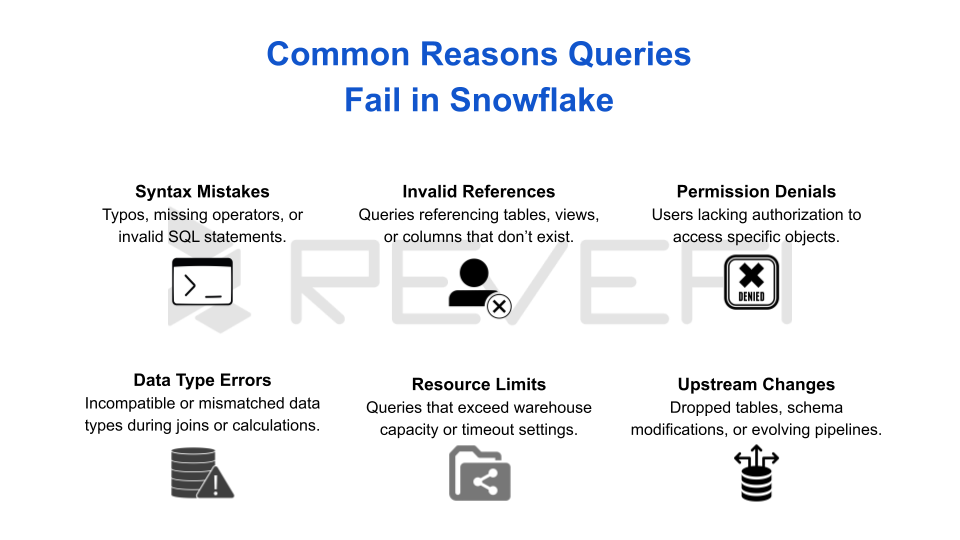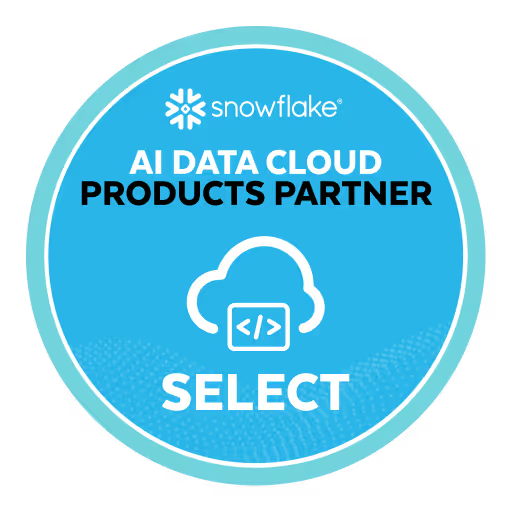Snowflake is a cloud data platform for enterprises seeking scalable, elastic, and high-performance data warehouse and analytics. Its consumption-based pricing aligns well with modern business models, enabling organizations to pay for what they use.
However, this very model also introduces a critical risk for cost control and operational efficiency in lieu of failed queries. From a financial perspective, every failed query consumes Snowflake credits without producing value.
At an operational level, failures slow down analytics, divert engineering capacity, and disrupt critical business processes. At scale, query failures can inflate cloud bills, reduce productivity, and expose weaknesses in governance, schema evolution, and access management.
Identifying high-error users (individuals or teams responsible for the majority of failed queries) provides an actionable lever to reduce waste, accelerate insights, and improve overall data reliability.
This article explores why failed queries represent more than technical errors, the hidden financial and operational risks they create, and how AI agents are empowering enterprises to analyze error patterns, and prevent recurring failures.
The Cost of Failed Queries in Snowflake
In Snowflake, even failed queries consume compute resources and credits. As a result, many organizations underestimate the financial and operational impact of query failures. This means mistakes cost money, sometimes at a scale that surprises even seasoned data leaders!
How failed queries impact budgets and teams:
- Wasted Snowflake Credits
Since Snowflake charges for compute resource/credit usage, failed queries drain credits without producing any results. - Productivity Loss
Data engineers, and analysts must re-run or troubleshoot queries, creating bottlenecks and slowing down project timelines. - Performance Bottlenecks
Failed queries still tie up compute warehouses, which can delay other workloads running on the same environment. - Data Quality Concerns
Frequent query errors often point to underlying issues such as schema mismatches or broken pipelines, which undermine confidence in analytics and dashboards.

In such a scenario, failed queries evolve from a performance issue into a full-blow crisis that can eventually spiral out of control for all the involved stakeholders.
Why Identifying High-Error Users Is Essential
Not every user contributes to query failures! In most organizations, a small percentage of users account for the majority of errors. Without visibility into who these high-error users are, wasted spend and inefficiencies remain hidden.
Benefits of identifying users with multiple failed queries:
- Early Problem Detection
If certain teams constantly fail queries, it may signal broader issues like missing permissions, evolving schemas, or broken ETL processes. - Greater Team Efficiency
Fixing recurring query issues reduces wasted cycles, freeing data teams to focus on insights instead of troubleshooting. - Direct Cost Savings
Cutting failed queries directly reduces Snowflake credit consumption. - Improved Data Quality
With fewer errors, pipelines run smoothly, dashboards refresh accurately, and decision-makers trust the data they’re using.
Spotting high-error users isn’t about blame, but rather it’s about building stronger, more efficient data operations.

How RADEN Simplifies Error Detection, and Cost Optimization
Revefi’s AI Agent for Data Spend Optimization (or RADEN) comes in handy as it helps understand the raw query logs as actionable insights that reduce costs and improve efficiency.
Key ways RADEN helps:
- Identifies High-Error Users Instantly
RADEN scans query history to highlight users with the most failures, allowing teams to focus on the root sources of inefficiency. - Breaks Down Error Codes
By categorizing failures by error type, RADEN shows whether issues stem from permissions, syntax, or schema problems. - Reduces Recurring Errors
Insights enable teams to fix systemic issues, provide training, and strengthen processes. - Optimizes Snowflake Spend
Every avoided query failure saves credits, directly lowering costs. - Strengthens Data Reliability
With fewer failures, data pipelines run consistently, dashboards refresh accurately, and business stakeholders gain confidence in the results

Strategic Impact: Cost Savings and Trustworthy Data
While resolving failed queries may seem tactical, it supports two critical organizational goals:
- Snowflake Cost Optimization
Reducing failed queries means fewer wasted credits, which translates directly into lower bills. For large enterprises, the savings can be significant. - Reliable Data Operations
When queries execute successfully, dashboards update correctly, and analytics pipelines run smoothly. This strengthens confidence in the data and supports faster, better business decisions.
Conclusion
Failed queries in Snowflake are more than minor mistakes—they’re budget drains and barriers to productivity. By identifying and addressing users with multiple failed queries, organizations can cut costs, streamline workloads, and improve the overall reliability of their data systems.
RADEN, Revefi’s AI Agent for Data Spend Optimization, makes this possible. By spotting high-error users, analyzing error patterns, and reducing recurring failures, RADEN helps teams turn query failures into a powerful opportunity for savings and efficiency.
In today’s data-driven world, every Snowflake credit counts. With RADEN, you make sure they’re spent where they deliver the most value.










